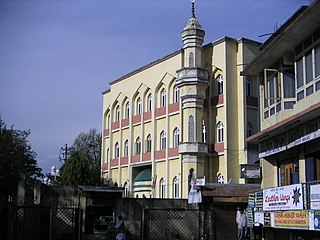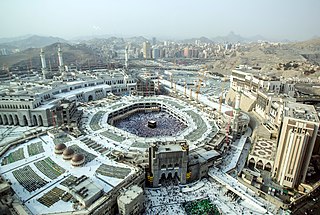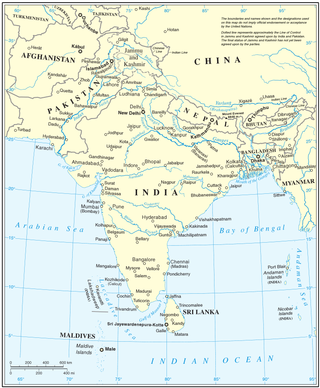
The Prophet's Mosque is the second mosque built by the Islamic prophet Muhammad in Medina, after that of Quba, as well as the second largest mosque and holiest site in Islam, after the Masjid al-Haram in Mecca, in the Saudi region of the Hejaz. The mosque is located at the heart of Medina, and is a major site of pilgrimage that falls under the purview of the Custodian of the Two Holy Mosques.

Islam is the official religion of the United Arab Emirates. Of the total population, 76.9% are Muslims as of a 2010 estimate by the Pew Research Center. Although no official statistics are available for the breakdown between Sunni and Shia Muslims among noncitizen residents, media estimates suggest less than 20 percent of the noncitizen Muslim population are Shia.

Islam constitutes the third largest religion in Singapore, with Muslims accounting for approximately 15.6% of the population, as indicated by the 2020 census. Predominantly, Singaporean Muslims are Sunni Muslims adhering to either the Shafi‘i or Hanafi schools of thought. The majority of the Muslim population, about 80%, are ethnic Malays, while 13% are of Indian descent. The remaining fraction comprises local Chinese, Eurasian, and Arab communities, in addition to foreign migrants. Buddhism and Christianity are the two larger religious affiliations in the country.

Istiqlal Mosque in Jakarta, Indonesia is the largest mosque in Southeast Asia and the ninth largest mosque in the world in terms of worshipper capacity. Built to commemorate Indonesian independence, this national mosque of Indonesia was named "Istiqlal", an Arabic word for "independence". The mosque was opened to the public on 22 February 1978. Within Jakarta, the mosque is positioned next to Merdeka Square, the Jakarta Cathedral (Catholic), and also of the Immanuel Church (Reformed).

Sunni Islam is, by far, the most widely practiced religion in Tajikistan. Sunni Islam of the Hanafi school is the recognized religious tradition of Tajikistan since 2009. According to a 2009 U.S. State Department release, the population of Tajikistan is 98% Muslim,, with some Sufi orders.

The Directorate of Religious Affairs in Turkey is an official permanent state institution established in 1924 by the orders of Mustafa Kemal Atatürk under article 136 of the Constitution of Turkey to carry out some of the administrative duties previously managed by the Shaykh al-Islām, before the abolition of the Ottoman Caliphate. The President of the Directorate of Religious Affairs is considered the Grand Mufti of Turkey.

Islam is the second largest religion in Norway after Christianity. As of 2023, the number of Muslims living in Norway was 182,607. The majority of Muslims in Norway are Sunni, with a significant Shia minority. 55 percent of Muslims in the country live in Oslo and Viken. The vast majority of Muslims have an immigrant background, and very few Norwegians are Muslim.

Finland is Christian majority country, with Islam being a minority faith. The constitution of Finland ensures freedom of religion and Muslims are free to proselytize and build places of worship in the country.
Religion in Nepal encompasses a wide diversity of groups and beliefs. Nepal is a secular nation and secularism in Nepal under the Interim constitution is defined as "Religious and cultural freedom along with the protection of religion and culture handed down from time immemorial." That is, "The state government is bound for protecting and fostering Hindu religion while maintaining "Religious" and "Cultural" freedom throughout the nation as fundamental rights.

Islam is the third largest religion in Nepal. According to the 2021 Nepal census, approximately 1.483 million Muslims, comprising 5.09% of the population, live in Nepal.

Lists of mosques cover mosques, places of worship for Muslims. The lists include the most famous, largest and oldest mosques, and mosques mentioned in the Quran, as well as lists of mosques in each region and country of the world. The major regions, Africa, Americas, Asia, Europe and Oceania are sorted alphabetically. The sub-regions, such as Northeast and Northwest Africa in Africa, and Arabia and South Asia in Asia, are sorted by the dates in which their first mosques were reportedly established, more or less, barring those that are mentioned by name in the Quran.
Islam is the majority and official religion in the United Arab Emirates, professed by 74.5% of the population as of 2020. 63.3% are Sunni, 6.7% are Shia, while 4.4% follow another branch of Islam. The Al Nahyan and Al Maktoum ruling families adhere to the Maliki school of jurisprudence. Many followers of the Hanbali school are found in Sharjah, Umm al-Quwain, Ras al-Khaimah and Ajman. Their followers include the Al Qasimi ruling family. The other main religions present in the country include Christianity (12.9%), Hinduism (6.2%), and Buddhism (3.2%). Zoroastrians, Druze, Baha'i, Judaism, and Sikhism are also practiced by some non-nationals. 1.3% of the population is agnostic.

The Great Mosque of Sana'a is an ancient mosque in Sana'a, Yemen, and one of the oldest mosques in the world. The mosque is said to have been founded in the early Islamic period, suggested to be in 633. While the precise date of construction is unknown, the earliest recorded renovations occurred under Caliph al-Walid I in the early 8th century, implying a possible earlier date of construction. The mosque was reportedly built in part from spolia from the Himyarite-era Ghumdan Palace and from the Axumite Christian Church of al-Qalis that formerly occupied the site. The Great Mosque is the largest and most notable of over one hundred mosques in the Old City of Sana’a.
Nepalese Muslims are Nepalis who follow Islam. Their ancestors arrived in Nepal from different parts of South Asia, Central Asia and Tibet during different epochs, and have since lived amidst the numerically dominant Hindus and Buddhists. About 80% of the Muslim community live in the Terai region, while the other 20% are found mainly in the city of Kathmandu and Gorkha and the western hills. The community numbers 971,056, about 3.8% of the total population of Nepal. Districts with large Muslim population include Sarlahi (9.9%), Rautahat (17.2%), Bara (11.9%), and Parsa (17.3%) and Banke (16%) in the western Terai and Siraha (7%) and Sunsari (10%) and Saptari (10%) Gorkha (13%) hill.

Masjid al-Haram, also known as the Sacred Mosque or the Great Mosque of Mecca, is considered to be the most significant mosque in Islam. It encloses the vicinity of the Kaaba in Mecca, in the Mecca Province of Saudi Arabia. It is among the pilgrimage sites associated with the Hajj, which every Muslim must perform at least once in their lives if able. It is also the main site for the performance of ʿUmrah, the lesser pilgrimage that can be undertaken any time of the year. The rites of both pilgrimages include circumambulating the Kaaba within the mosque. The Great Mosque includes other important significant sites, such as the Black Stone, the Zamzam Well, Maqam Ibrahim, and the hills of Safa and Marwa.

The Ibrahim Mosque is a mosque in Mong Kok, Hong Kong. It is the sixth and latest mosque built in Hong Kong. The mosque was constructed and is managed by the United Welfare Union Hong Kong Limited.

Currently the largest mosque in Turkey, the Grand Çamlıca Mosque is a landmark complex for Islamic worship which was completed and opened on 7 March 2019. The mosque stands astride Çamlıca Hill in the Üsküdar district of Istanbul and is visible from much of the centre of the city. The complex incorporates an art gallery, library, and conference hall. It can hold up to 63,000 worshippers at a time.

Islam is the second-largest religion in South Asia, with more than 640 million Muslims living there, forming about one-third of the region's population. Islam first spread along the coastal regions of the Indian subcontinent and Sri Lanka, almost as soon as it started in the Arabian Peninsula, as the Arab traders brought it to South Asia. South Asia has the largest population of Muslims in the world, with about one-third of all Muslims living here. Islam is the dominant religion in half of the South Asian countries. It is the second largest religion in India and third largest in Sri Lanka and Nepal.
The 2004 Nepal riots were a series of riots between 31 August to 6 September 2004. Thousands of people rioted in cities and towns across Nepal, which saw looting, arson, as well as imposed curfew and the deaths of two people.














